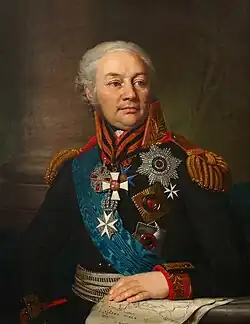Friedrich Wilhelm von Buxhoeveden
Friedrich Wilhelm von Buxhoeveden | |
|---|---|
 Portrait by Vladimir Borovikovsky, c. 1809 | |
| Governor General of Livonia | |
| In office 1808–1809 | |
| Preceded by | Count Alexander Tormasov |
| Succeeded by | Prince Dmitry Lobanov-Rostovsky |
| In office 1803–1806 | |
| Preceded by | Prince Sergei Golitsyn |
| Succeeded by | Count Alexander Tormasov |
| Governor General of Saint Petersburg | |
| In office 1797–1798 | |
| Preceded by | Nikolai Arkharov |
| Succeeded by | Peter Ludwig von der Pahlen |
| Personal details | |
| Born | September 13, 1750 Muhu, Governate of Riga, Russian Empire |
| Died | September 4, 1811 (aged 60) Lode Castle, Wiek, Governorate of Estonia, Russian Empire |
| Education | Second Cadet Corps |
| Military service | |
| Allegiance | |
| Branch/service | |
| Years of service | 1770–1798, 1802–1810 |
| Rank | General of Infantry |
| Unit | Kexholm Life Guards Regiment |
| Commands |
|
| Battles/wars | |
Friedrich Wilhelm Graf von Buxhoeveden[a] (Russian: Фёдор Фёдорович Буксгевден, romanized: Fyodor Fyodorovich Buksgevden; September 13 [O.S. September 2] 1750 – September 4 [O.S. August 23] 1811) was a Russian general of the infantry and government official. Buxhoeveden commanded the Russian armies during the Finnish War.[2]
Family
The Buxhoevedens, a Baltic German family from Estonia, traced their roots to Bexhövede in Lower Saxony.
Buxhoevden's wife, countess Natalia Alexeyeva, was the illegitimate daughter of Grigory Orlov (1734–1783) by a lady of the court, but her mother – contrary to some claims – was not the Empress Catherine, but a member of the Apraksin family. Buxhoeveden's granddaughter Varvara Nelidova was a mistress of Nicholas I of Russia (1796–1855) for 17 years (1832–1855).
Career
In 1805, Buxhoevden took part in the Battle of Austerlitz as a commander, contributing to the Third Coalition's failure to defeat Napoleon by being drunk during the battle.[3]
In 1808, he served as Commander-in-Chief in the Russian conquest of Finland, and led Russian troops during the initial battles of the Finnish War (1808–1809).
Estates
Buxhoevden received the castle and lands of Koluvere in western Estonia after Duchess Augusta of Brunswick-Wolfenbüttel had died there in 1788 in suspicious circumstances. He also owned the villa and manor of Ligovo near Saint Petersburg.
Awards
Russian Empire awards:
- Order of Saint George, 4th Degree (26 November 1774)
- Order of Saint George, 3rd Degree (22 August 1789)
- Order of Saint Anna (8 September 1790)
- Cross "For the Capture of Praga" (1794)
- Golden Weapon for Bravery with diamonds (1794)
- Order of Saint Vladimir, 2nd Class (1794)
- Order of Saint Alexander Nevsky (15 February 1797)
- Order of Saint Vladimir, 1st Degree (1806)
- Order of the Holy Apostle Andrew the First-Called (17 September 1807), diamond badges added in 1808
- Order of Saint George, 2nd Degree (27 April 1808)
Foreign state awards:
- Order of the White Eagle, 1795 from the Polish–Lithuanian Commonwealth
- Order of Saint Stanislaus, 1795, from the Polish–Lithuanian Commonwealth
- Order of the Black Eagle, from Kingdom of Prussia
- Order of Saint John of Jerusalem, from Kingdom of Prussia
See also
- Albert of Buxhoeveden (c. 1165–1229), an earlier member of the family
Notes
- ^ Other spellings include Feodor Buxhoevden, Buxhœwden, and Buxhöwden.
References
- ^ Battle of Austerlitz order of battle
- ^ "Fredrik Vilhelm von Buxhoevden". Biografiskt lexikon för Finland (in Swedish). Helsingfors: Svenska litteratursällskapet i Finland. urn:NBN:fi:sls-4129-1416928956735.
- ^ Todd Fisher & Gregory Fremont-Barnes, The Napoleonic Wars: The Rise and Fall of an Empire. p. 52
Sources
- . Brockhaus and Efron Encyclopedic Dictionary (in Russian). 1906.
External links
- "Fredrik Vilhelm von Buxhoevden". Biografiskt lexikon för Finland (in Swedish). Helsingfors: Svenska litteratursällskapet i Finland. urn:NBN:fi:sls-4129-1416928956735.
- (in Russian) Biography
- (in English) From Buxhoeveden family tree